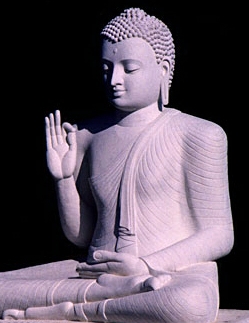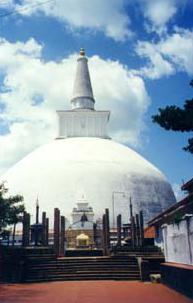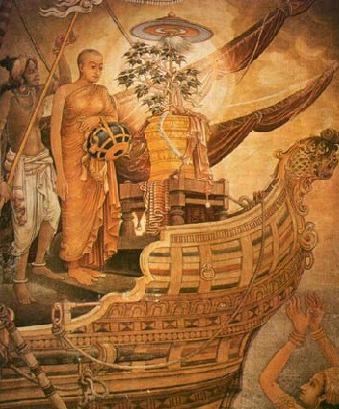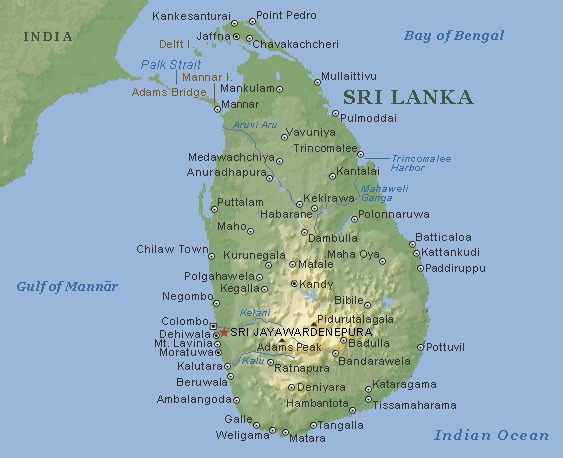
WHAT MAN HATH DONE TO MAN
Massacre of Pilgrims By Tamil Tigers Remembered
15th May 1998 - Anuradhapura, Sri Lanka
Thirteen years ago to the day, on the 14th May 1985, hundreds of Sinhala civilian pilgrims made their way to the holy city of Anuradhapura to mediate and observe 'sil' under the sacred Bo tree. Tragically, the peace and tranquillity of the sacred city of Anuradhapura was shattered with the sharp gun fire of Kaleshnikovs aimed at pilgrims engaged in prayer, killing 120 pilgrims and causing severe injuries to over 80 others.
Men, women, children, and even infants, were among the victims of the Tamil Tiger terrorists who came in two busloads, armed with Kaleshnikovs. The murdering of these pilgrims at a sacred Buddhist site in Sri Lanka can be equated to Roman Catholics being massacred by crazed gunmen while engaged in Sunday Mass at the Vatican in Rome.
The sacred Sri Maha Bodhi at Anuradhapura is the oldest tree in the records of the world, as it is a sapling of the original Bo tree that Lord Buddha sat under and meditated over 2550 years ago. Anuradhapura is the one of Sri Lanka's ancient capitals, and it is famous for its unique and rich cultural heritage, a heritage now defiled with innocent blood.
The Tamil Tigers' blatant disregard for the Buddhist religion is amply demonstrated by their heinous act of gunning down pilgrims engaged in prayer. Never in their wildest dreams would these innocent pilgrims have thought that their lives would be so viciously snuffed out by indiscriminating bullets within the safe haven of a religious sanctuary! The Tigers, who are engaged in battle in Sri Lanka, are fighting for an unjustified request for a separate homeland. To attain their goal, they have resorted to the undemocratic means of slaughtering innocent people that stand in their way.
By killing Buddhist pilgrims at a venerated site, Tamil terrorists sought to introduce a new dimension to this conflict - religion. The crisis Sri Lanka is facing due to the sheer lunacy of the Tigers is not a conflict that has come about due to religious conflicts, but more, a conflict that has arisen due to ethnic differences that the Tamils have blown way out of proportion for their own political and territorial gains.
This ongoing conflict has now claimed the lives of over 75,000 people, the majority of them being innocent civilians caught up in a war they themselves did not choose. The 120 innocent pilgrims that were gunned down under the sacred Sri Maha Bodhi must never be forgotten, for it was a blatant act of sacrilege committed by deranged terrorists. It is utterly deplorable and morally unacceptable! Although it has been thirteen years since the senseless slaughter of civilians at Anuradhapura took place, it remains to this day very fresh in the minds of the Sinhala community and Buddhists everywhere.
For they shall not be forgotten. Om mani padme hum.
Copyright ©The SJM News
Above article edited for clarity of thought and expression @buddhavision
Comment: Is the Tamils' request for a separate homeland "unjustfied" when you take into consideration the history of the island? And is not Buddhism being used by the government of Sri
Lanka as an opiate of the masses, as a ruling ideology, as it goes about physically and politically oppressing the Tamil people in the north?
Whether the Tamils' struggle for a separate homeland is justified or not, there really is no moral justification for slaughtering innoncent people at prayer at any holy site! It's obvious that both sides in this ongoing land dispute have forgotten that all men are brothers!
*For an article intended for a sympathetic Buddhist audience, the above diatribe is certainly full of negative karma, although it does help the Western mind to comprehend just how deep ethnic and religious conflicts run in Sri Lanka, formerly Ceylon, aka another paradise lost!
No wonder recent tsunami relief efforts will remain a tightrope walk for Western politicians and international aid agencies.
Anuradhapura

The sacred city of Anuradhapura, the first capital of Sri Lanka and now a UNESCO world heritage site, was established around a cutting from the 'Bodhi tree', the fig tree Prince Siddhartha
achieved enlightenment under near the banks of the Niranjana River in northern India five centuries before Christ. The
cutting was planted there in the 3rd century B.C. by Theri Sanghamitta, the founder of an order of Buddhist nuns ... |

Anuradhapura flourished for 1,300 years, but was abandoned after the Chola invasion in 993. During the time of Raja Raja Cholan and Rajendra Cholan 993-1070 AD, the entire island was brought under Tamil rule.
The Chola capital was established in Polanuruvaiand, and the Sinhala people moved southwards. The islandís mountainous region and the south became the homeland of the Sinhalese. The Eastern, Northern and North-Western regions were inhabited by Tamils.
Hidden away in dense jungle for many years, the old sacred city, with its splendid palaces, monasteries and monuments, is once again accessible to local Buddhists and world travellers, though religious and political strife is just a shout away. |

Anuradhapura is situated 130 miles (205km) north of the capital, Colombo. As you can see, Sri Lanka is shaped very much like a mango. The island is 270 miles long and 140 miles across at its widest point, incorporating a variety of terrain and climate zones. It is located 550 miles North of the equator off the southern tip of India. Kandy was the last stronghold of Sinhalese kings. |

Various notes appended and edited @buddhavision 2005